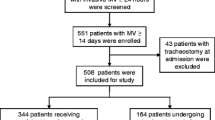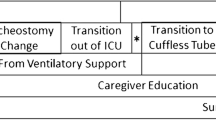Abstract
Tracheostomy has attracted increasing attention in recent years, owing to progress in team-based care and demonstrable advances in weaning and decannulation. While many factors that affect survivorship after ICU stay are poorly understood, tracheostomy plays an important role in alleviating this burden. These observations highlight the importance of modernizing tracheostomy practice using evidence-based approaches. The COVID-19 pandemic, has underscored the importance of effective tracheostomy practice in efficient resource allocation and optimizing survivorship outcomes following ICU stay.
Access this chapter
Tax calculation will be finalised at checkout
Purchases are for personal use only
Similar content being viewed by others
References
Liu CC, Livingstone D, Dixon E, Dort JC. Early versus late tracheostomy: a systematic review and meta-analysis. Otolaryngol Head Nek Surg. 2015;152:219–27.
Hosokawa K, Nishimura M, Egi M, Vincent JL. Timing of tracheotomy in ICU patients: a systematic review of randomized controlled trials. Crit Care. 2015;19:424.
Szakmany T, Russell P, Wilkes AR, Hall JE. Effect of early tracheostomy on resource utilization and clinical outcomes in critically ill patients: meta-analusis of randomized controlled trials. Br J Anaesth. 2015;114:396–405.
Siempos II, Ntaidou TK, Filippidis FT, Choi AMK. Effect of early verus late or no tracheostomy on mortality and pneumonia of critically ill patients receiving mechanical ventilation: a systematic review and meta-analysis. Lancet Respir Med. 2015;3:150–8.
Wang R, Pan C, Wang X, Xu F, Jiang S, Li M. The impact of tracheostomy timing in critically ill patients undergoing mechanical ventilation: a meta-analysis of randomized controlled trials with sequential analysis. Heart Lung. 2019;48:46–54.
Khammas AH, Dawood MR. Timing of tracheostomy in intensive care unit patients. Int Arch Otolaryngol. 2018;22:437–42.
Chorath K, Hoang A, Rajasekaran K, Moreira A. Association of early vs late tracheostomy placement with pneumonia and ventilator days in critically ill patients a meta-analysis. JAMA Otolaryngol Head Neck Surg. 2021;147:450–9.
Cagino LM, Kercheval JB, Kenes MT, McSparron JI, Blank R, Chinn SB, et al. Association of tracheostomy with changes in sedation during COVID-19: a quality improvement evaluation at the University of Michigan. Ann Am Thorac Soc. 2021;18:907–9.
Sutt AL, Tronstad O, Barnett AG, Kitchenman S, Fraser JF. Earlier tracheostomy is associated with an earlier return to walking, talking, and eating. Aust Crit Care. 2020;33:213–8.
Young D, Harrison DA, Cuthbertson BH, Rowan K. Effect of early vs late tracheostomy placement on survival in patients receiving mechanical ventilation. The TrachMan randomized trial. JAMA. 2013;309:2121–9.
Terragni PP, Antonelli M, Fumagalli R, Faggiano C, Berardino M, Pallavicini FB, et al. Early vs late tracheostomy for prevention of penumonia in mechanically ventilated adult ICU patients. A randomized controlled trial. JAMA. 2010;303:1483–9.
Diaz-Prieto A, Mateu A, Gorriz M, Ortiga B, Truchero C, Sampietro N, et al. A randomized clinical trial for the timing of tracheostomy in critically ill patients: factors precluding inclusion in a single center study. Crit Care. 2014;18:585.
Aviles-Jurado FX, Prieto-Alhambra D, Gonzalez-Sanchez N, de Ossó J, Arancibia C, Rojas-Lechuga MJ, et al. Timing, complications, and safety of tracheotomy in critically ill patients with COVID-19. JAMA Otolaryngol Head Neck Surg. 2021;147:41–8.
Abe T, Madotto F, Pham T, Nagata I, Uchida M, Tamiya N, et al. Epidemiology and patterns of tracheostomy practice in patients with acute respiratory distress syndrome in ICUs across 50 countries. Crit Care. 2018;22:195.
Bier-Laning C, Cramer JD, Roy S, Palmieri PA, Amin A, Añon JM, et al. Tracheostomy during the COVID-19 pandemic: comparison of international perioperatove protocols and practices in 26 countries. Otolaryngol Head Neck Surg. 2021;164:1136–114.
McGrath B, Brenner MJ, Warrillow SJ, Pandian V, Arora A, Cameron TS, et al. Tracheostomy in the COVID-19 era: global and multidisciplinary guidance. Lancet Respir Med. 2020;8:717–25.
Villalonga-Vadell R, Martin Delgado MC, Aviles-Jurado FX, Álvarez Escudero J, Aldecoa Álvarez-Santuyano C, de Haro López C, et al. Consensus document of the Spanish Society of intensive and critical care medicine and coronary units (SEMICYUC), the Spanish Society of Otolaryngology and Head and Neck Surgery (SEORL-CCC) and the Spanish Society of Anesthesiology and critical care (SEDAR) on tracheostomy in patients with COVID-19 infection. Rev Esp Anestesiol Reanim. 2020;67:504–10.
Lamb CR, Desai NR, Angel L, Chaddha U, Sachdeva A, Sethi S, et al. Use of tracheostomy during the COVID-19 pandemic: American College of Chest Physicians/American Association for Bronchology and Interventional Pulmonology/Association of Interventional Pulmonology Program Directors Expert Panel Report. Chest. 2020;158:1499–514.
Kwak PE, Connors JR, Benedict PA, Timen MR, Wang B, Zhang Y, et al. Early outcomes from early tracheostomy for patients with COVID-19. JAMA Otolaryngol Head Neck Surg. 2020;147:239–44.
Ghauri SK, Javaeed A, Mustafa KJ, Khan AS. Predictors of prolonged mechanical ventilation in patients admitted to intensive care units: a systematic review. Int J Health Sci (Qassim). 2019;13:31–8.
Clark PA, Inocencio RC, Lettieri CJ. I-TRACH: validating a tool for predicting prolonged mechanical ventilation. J Intens Care Med. 2018;33:567–73.
COVID-19 Group on Behalf of the REVA Network and the COVID-ICU Investigators. Clinical characteristics and day-90 outcomes of 4244 critically ill adults with COVID-19: a prospective cohort study. Intensive Care Med. 2021;47:60–73.
Takhar A, Surda P, Ahmad I, Amin N, Arora A, Camporota L, et al. Timing of tracheostomy for prolonged respiratory wean in critically ill coronavirus disease 2019 patients: a machine learning approach. Crit Care Explor. 2020;2:e0279.
Mlodzinski E, Stone DJ, Celi LA. Machine learning for pulmonary and critical care medicine: a narrative review. Pulm Ther. 2020;6:67–77.
Pandian V, Murgu S, Lamb CR. Counterpoint: Tracheostomy in patients with COVID-19, should we do it before 14 days? No. Chest 2021;159:1727–29.
Weiss TT, Cerda F, Scott JB, Kaur R, Sungurlu S, Mirza SH, et al. Prone positioning for patients intubated for severe acute respiratory distress syndrome (ARDS) secondary to COVID-19: a retrospective observational cohort study. Br J Anaesth. 2021;126:48–55.
Guerin C, Reignier J, Richard JC, Beuret P, Gacouin A, Boulain T, et al. Prone positioning in severe acute respiratory distress syndrome. N Engl J Med. 2013;368:2159–68.
Tran K, Cimon K, Severn M, Pessoa-Silva CL, Conly J. Aerosol generating procedures and risk of transmission of acute respiratory infections to healthcare workers: a systematic review. PLoS One. 2012;7:e35797.
Chen WQ, Ling WH, Lu CY, Hao YT, Lin ZN, Ling L, et al. Which preventive measures might protect health care workers from SARS? BMC Public Health. 2009;9:81.
Rosano A, Martinelli E, Fusina F, Albani F, Caserta R, Morandi A, et al. Early percutaneous tracheostomy in coronavirus disease 2019: association with hospital mortality and factors associated with removal of tracheostomy tube at ICU discharge. A cohort study on 121 patients. Crit Care Med. 2021;49:261–70.
Jubran A, Grant BJB, Duffner LA, Collins EG, Lanuza DM, Hoffman LA, Tobin MJ. Effect of pressure support vs unassisted breathing through a tracheostomy collar on weaning duration in patients requiring prolonged mechanical ventilation: a randomized trial. JAMA. 2013;309:671–7.
Hernandez G, Pedrosa A, Ortiz R, Cruz Accuaroni Mdel M, Cuena R, Vaquero Collado C, et al. The effects of increasing effective airway diameter on weaning from mechanical ventilation in tracheostomized patients: a randomized controlled trial. Intensive Care Med. 2013;39:1063–70.
Hernandez G, Rodriguez ML, Vaquero MC, Ortiz R, Masclans JR, Roca O, et al. High-flow oxygen with capping or suctioning for tracheostomy decannulation. N Engl J Med. 2020;383:1009–17.
Alhazzani W, Møller MH, Arabi YM, Loeb M, Gong MN, Fan E, et al. Surviving Sepsis Campaign: guidelines on the management of critically ill adults with Coronavirus Disease 2019 (COVID-19). Intensive Care Med. 2020;46:854–87.
Pandian V, Brodsky MB, Brigham EP, Parker AM, Hillel AT, Levy JM, et al. COVID-19 survivorship: How otolaryngologist-head and neck surgeons can restore quality of life after critical illness. Am J Otolaryngol. 2021;42:102917.
Rouhani MJ, Clunie G, Thong G, Lovell L, Roe J, Ashcroft M, et al. A prospective study of voice, swallow, and airway outcomes following tracheostomy for COVID-19. Laryngoscope. 2021;131:E1918–E1925.
Phua J, Weng L, Ling L, Egi M, Lim CM, Divatia JV, et al. Intensive care management of coronavirus disease 2019 (COVID-19): challenges and recommendations. Lancet Respir Med. 2020;8:506–17.
Aziz S, Arabi YM, Alhazzani W, Evans L, Citerio G, Fischkoff K, et al. Managing ICU surge during the COVID-19 crisis: rapid guidelines. Intensive Care Med. 2020;46:1303–25.
Author information
Authors and Affiliations
Corresponding author
Editor information
Editors and Affiliations
Rights and permissions
Copyright information
© 2021 The Author(s), under exclusive license to Springer Nature Switzerland AG
About this chapter
Cite this chapter
Hernandez, G., Brenner, M., McGrath, B.A. (2021). Modernizing Tracheostomy Practice to Improve Resource Utilization and Survivorship Outcomes. In: Vincent, JL. (eds) Annual Update in Intensive Care and Emergency Medicine 2021. Annual Update in Intensive Care and Emergency Medicine. Springer, Cham. https://doi.org/10.1007/978-3-030-73231-8_13
Download citation
DOI: https://doi.org/10.1007/978-3-030-73231-8_13
Published:
Publisher Name: Springer, Cham
Print ISBN: 978-3-030-73230-1
Online ISBN: 978-3-030-73231-8
eBook Packages: MedicineMedicine (R0)




